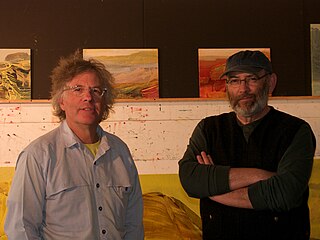
The Eiteljorg Museum of American Indians and Western Art is an art museum in downtown Indianapolis, Indiana, United States. The Eiteljorg houses an extensive collection of visual arts by indigenous peoples of the Americas as well as Western American paintings and sculptures collected by businessman and philanthropist Harrison Eiteljorg (1903–1997). The museum houses one of the finest collections of Native contemporary art in the world.

Harry Eugene Fonseca was a Nisenan Native American artist, and illustrator. He was an enrolled citizen of the Shingle Springs Band of Miwok Indians.
Mario Martinez is a Native American contemporary abstract painter. He is a member of the Pascua Yaqui Tribe from New Penjamo, the smallest of six Yaqui settlements, in Arizona. He currently lives in New York City.

George Morrison was an Ojibwe abstract painter and sculptor from Minnesota. His Ojibwe name was Wah Wah Teh Go Nay Ga Bo. Morrison's work is associated with the Abstract Expressionist movement in the United States.
Kay WalkingStick is a Native American landscape artist and a member of the Cherokee Nation. Her later landscape paintings, executed in oil paint on wood panels often include patterns based on Southwest American Indian rugs, pottery, and other artworks.

The visual arts of the Indigenous peoples of the Americas encompasses the visual artistic practices of the Indigenous peoples of the Americas from ancient times to the present. These include works from South America and North America, which includes Central America and Greenland. The Siberian Yupiit, who have great cultural overlap with Native Alaskan Yupiit, are also included.

James Luna was a Puyukitchum, Ipai, and Mexican-American performance artist, photographer and multimedia installation artist. His work is best known for challenging the ways in which conventional museum exhibitions depict Native Americans. With recurring themes of multiculturalism, alcoholism, and colonialism, his work was often comedic and theatrical in nature. In 2017 he was awarded a Guggenheim Fellowship.

This is a chronological list of significant or pivotal moments in the development of Native American art or the visual arts of the Indigenous peoples of the Americas. Earlier dates, especially before the 18th century, are mostly approximate.

James Lavadour is an American painter and printmaker. A member of the Walla Walla tribe, he is known for creating large panel sets of landscape paintings. Lavadour is the co-founder of the Crow's Shadow Institute of the Arts.
I believe that a painting must stand up on its own without explanation. I think of myself as an abstract action painter. I just happen to see landscape in the abstract events of paint. - James Lavadour
Bonnie Devine is a Serpent River Ojibwa installation artist, performance artist, sculptor, curator, and writer from Serpent River First Nation, who lives and works in Toronto, Ontario. She is currently an associate professor at OCAD University and the founding chair of its Indigenous Visual Cultural Program.
Corwin "Corky" Clairmont is a printmaker and conceptual and installation artist from the Confederated Salish and Kootenai Tribes of the Flathead Nation. Known for his high concept and politically charged works, Clairmont seeks to explore situations that affect Indian Country historically and in contemporary times.
I don't put work out that gives solutions but provokes questions. - Corky Clairmont
Lorenzo Clayton is a contemporary Navajo sculptor, printmaker, conceptual and installation artist. His artwork is notable for exploring the concepts of spirituality through abstraction.
Dana Claxton is a Hunkpapa Lakota filmmaker, photographer, and performance artist. Her work looks at stereotypes, historical context, and gender studies of Indigenous peoples of the Americas, specifically those of the First Nations. In 2007, she was awarded an Eiteljorg Fellowship for Native American Fine Art.

Nicholas Galanin is a Tlingit and Unangax̂ multi-disciplinary artist and musician from Alaska. His work often explores a dialogue of change and identity between Native and non-Native communities.

Wendy Red Star is an Apsáalooke contemporary multimedia artist born in Billings, Montana, in the United States. Her humorous approach and use of Native American images from traditional media draw the viewer into her work, while also confronting romanticized representations. She juxtaposes popular depictions of Native Americans with authentic cultural and gender identities. Her work has been described as "funny, brash, and surreal".
Skawennati is a Mohawk multimedia artist, best known for her online works as well as Machinima that explore contemporary Indigenous cultures, and what Indigenous life might look like in futures inspired by science fiction. She served as the 2019 Indigenous Knowledge Holder at McGill University. In 2011, she was awarded an Eiteljorg Contemporary Art Fellowship which recognized her as one of "the best and most relevant native artists."
Jackson Polys is a Tlingit Native visual artist and filmmaker whose work is based between Alaska and New York. His work examines the constraints and potential in the desire for Indigenous advancement, while challenging existing gazes onto traditional Native culture. Polys is well known for his films, institutional critique, and carved sculptures incorporating materials such as abalone, glass, liquids, resins, silicone, as well as the ready-made.
Anna Tsouhlarakis is a Native American artist who creates installation, video, and performance art. She is an enrolled citizen of the Navajo Nation and of Muscogee Creek and Greek descent. Her work has been described as breaking stereotypes surrounding Native Americans and provoking thought, rather than focusing solely on aesthetics. Tsouhlarakis wants to redefine what Native American art means and its many possibilities. She also works at the University of Colorado Boulder as an Assistant professor.
The Space in Which to Place Me is an art exhibition at the 2024 Venice Biennale's American pavilion featuring works by painter and sculptor Jeffrey Gibson.










